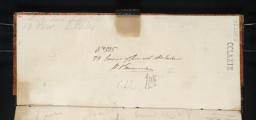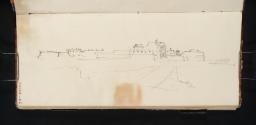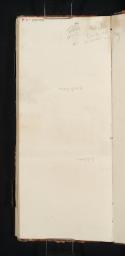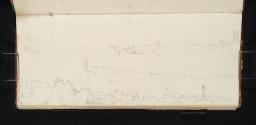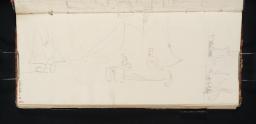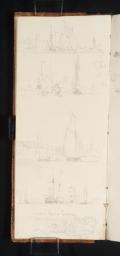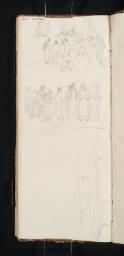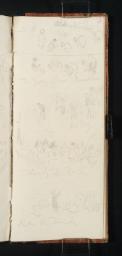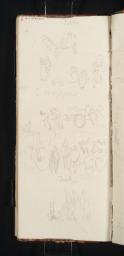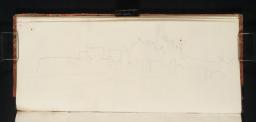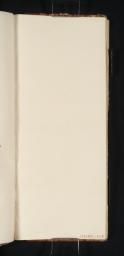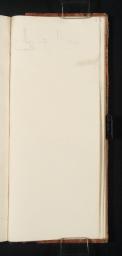Turner Bequest CCLXXIX 1–52a
Sketchbook quarter bound in boards in brown leather and marbled paper, with leather pencil holder
51 leaves of white wove paper, 206 x 86 mm
51 leaves of white wove paper, 206 x 86 mm
Accepted by the nation as part of the Turner Bequest 1856
Exhibition history
References
This thin, narrow pocketbook contains multiple pencil drawings of harbours, hillsides and shipping, many of which are locatable to the Kentish coast and countryside. As the art historian Ian Warrell has pointed out, Turner particularly favoured sketchbooks of this ‘almanac’ format in the later years of the 1830s.1 However, the pages of this particular volume bear the watermark 1823 so the dating for the drawing to about 1832 given in A.J. Finberg’s 1909 inventory is retained here.2 As Turner biographer Anthony Bailey has noted, at this time Turner was particularly active in gathering medicine recipes of the type recorded in the inside back cover (D41145) as cholera spread through Europe.3 Stylistically the drawings are fairly consistent throughout although they range in detail from loose outline drawings like folio 3 verso (D27285; Turner Bequest CCLXXIX 3a) to somewhat more detailed architectural studies like folio 32 verso (D27326; Turner Bequest CCLXXIX 32a).
The sketchbook is named after its studies of the Kentish towns of Gravesend and Margate although the former is only clearly identifiable on folio 1 recto (D27281; Turner Bequest CCLXXIX 1) thanks to Turner’s note to that effect on the page itself. Sketches of Margate on the other hand do recur frequently throughout the volume. As Matthews Imms has outlined in the introduction to the Marine Dabblers sketchbook of about 1829–30, Turner’s long-term interest in the picturesque potential of this location intensified in the 1830s as it intertwined with his relationship with Margate landlady Sophia Booth. The Tate collection includes impressions of engravings of the Channel harbour after Turner of around this date, such as T04590. There are also contemporary colour studies of the surrounding seaside in the Turner Bequest; see, for example, D25166 (Turner Bequest CCLXIII 44).
The pages on which views of Margate (and views probably taken at Margate) appear in this volume are as follows: folio 3 verso (D27285; Turner Bequest CCLXXIX 3a); folio 5 recto (D27287; Turner Bequest CCLXXIX 5); folio 5 verso (D27288; Turner Bequest CCLXXIX 5a); folio 7 recto (D27291; Turner Bequest CCLXXIX 7); folio 9 verso (D27295; Turner Bequest CCLXXIX 9a); folio 11 verso (D27298; Turner Bequest CCLXXIX 11a); folio 26 recto (D27313;Turner Bequest CCLXXIX 26); folio 26 verso (D27314;Turner Bequest CCLXXIX 26a); folio 27 recto (D27315; Turner Bequest CCLXXIX 27); folio 30 verso (D27322;
Turner Bequest CCLXXIX 30a); folio 31 verso (D27324; Turner Bequest CCLXXIX 31a); folio 32 recto (D27325; Turner Bequest CCLXXIX 32); folio 32 verso (D27326; Turner Bequest CCLXXIX 32a); folio 33 recto (D27327; Turner Bequest CCLXXIX 33); folio 33 verso (D27328; Turner Bequest CCLXXIX 33a); folio 41 recto (D27343; Turner Bequest CCLXXIX 41).
Turner Bequest CCLXXIX 30a); folio 31 verso (D27324; Turner Bequest CCLXXIX 31a); folio 32 recto (D27325; Turner Bequest CCLXXIX 32); folio 32 verso (D27326; Turner Bequest CCLXXIX 32a); folio 33 recto (D27327; Turner Bequest CCLXXIX 33); folio 33 verso (D27328; Turner Bequest CCLXXIX 33a); folio 41 recto (D27343; Turner Bequest CCLXXIX 41).
After Margate, the Kentish waterside settlements of Chatham on the River Medway and Ramsgate on the coast provide Turner with his most consistent themes in this volume. In a similar fashion, these locations fed his wider artistic activities. As noted by the curators of the 1995 exhibition Making & Meaning: Turner: The Fighting Temeraire, for example, drawings in the current sketchbook may have contributed to a 1832 engraving of Chatham after one of the artist’s watercolour compositions; see Tate impression T04588.4 By this date Turner had already composed a dramatic watercolour of a stormy Ramsgate harbour which is now in the Tate collection (D18150; Turner Bequest CCVIII Q). This was published as an engraving (T04831) as was the closely comparable design for T04413.
The pages on which views of Chatham (and views probably taken at Chatham) appear in this volume are as follows: folio 42 recto (D27345; Turner Bequest CCLXXIX 42); folio 42 verso (D27346; Turner Bequest CCLXXIX 42a); folio 44 recto (D27349; Turner Bequest CCLXXIX 44); folio 45 recto (D27351; Turner Bequest CCLXXIX 45); folio 45 verso (D27352; Turner Bequest CCLXXIX 45a); folio 46 recto (D27353; Turner Bequest CCLXXIX 46); folio 46 verso (D27354; Turner Bequest CCLXXIX 46a). Ramsgate (and views probably taken at Ramsgate) appear in this volume are as follows: folio 37 verso (D27336; Turner Bequest CCLXXIX 37a); folio 38 recto (D27337; Turner Bequest CCLXXIX 38); folio 38 verso (D27338; Turner Bequest CCLXXIX 38a); folio 39 verso (D27339; Turner Bequest CCLXXIX 39); folio 39 verso (D27340; Turner Bequest CCLXXIX 39a).
Ian Warrell, ‘Exploring the “Dark Side”: Ruskin and the Problem of Turner’s Erotica’, British Art Journal, vol.4, no.1, 2003, p.41.
A.J. Finberg, A Complete Inventory of the Drawings of the Turner Bequest, London 1909, vol.II, p.885–87.
Technical notes
How to cite
John Chu, ‘Gravesend and Margate Sketchbook’, sketchbook, March 2015, in David Blayney Brown (ed.), J.M.W. Turner: Sketchbooks, Drawings and Watercolours, Tate Research Publication, August 2016, https://www

